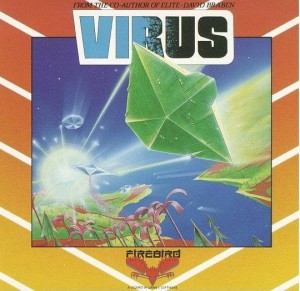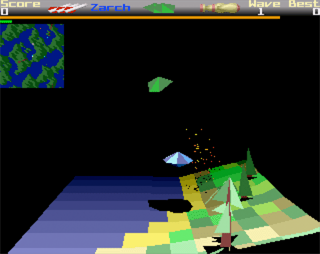 I’ve long considered Virus one of my very favorite videogames. Developed by David Braben (whose latest is Kinectimals) and published for the Amiga, Atari ST, and PC in 1988 by Firebird, Virus was one of the first filled-vector 3D games ever made.
I’ve long considered Virus one of my very favorite videogames. Developed by David Braben (whose latest is Kinectimals) and published for the Amiga, Atari ST, and PC in 1988 by Firebird, Virus was one of the first filled-vector 3D games ever made.
Virus puts you in control of a flying craft with the goal of defending Earth from an invading alien force that is spreading a deadly virus throughout the planet. Your craft, armed with cannons and missiles, flies over the varied landscape — all rendered in impressive (for the time) 3D — seeking out and destroying the various types of enemy ships. The experiencing of piloting your craft has something of a low-gravity, Lunar Lander-like feel to it. Points are gained at the end of each round of play for the percentage of uninfected land on the level map.
 The controls in Virus are particularly interesting. The core control system is mouse-based and would be quite difficult to describe in words. When I first tried the game on my Amiga 2000 in the late ’80s, it felt like the mouse controls must be broken, and I quickly gave up on them and switched to the backup, mediocre keyboard-based controls. But, it was after seeing how the controls were being so highly praised on FidoNET that I sat down, determined to figure it all out. And figure them out, I did, only to discover a highly sensitive and amazing control system that delivers almost eerily precise control of your craft. It just takes some time to learn.
The controls in Virus are particularly interesting. The core control system is mouse-based and would be quite difficult to describe in words. When I first tried the game on my Amiga 2000 in the late ’80s, it felt like the mouse controls must be broken, and I quickly gave up on them and switched to the backup, mediocre keyboard-based controls. But, it was after seeing how the controls were being so highly praised on FidoNET that I sat down, determined to figure it all out. And figure them out, I did, only to discover a highly sensitive and amazing control system that delivers almost eerily precise control of your craft. It just takes some time to learn.
A few years after discovering Virus, I came to understand that it is an adaptation of Braben’s Zarch, released a year earlier for the Acorn Archimedes, a distinctly British RISC-based platform rather more powerful than the more mainstream machines for which the dialed-down Virus was released. In fact, a sort-of “light” version of Zarch called Lander came bundled with the Archimedes to show off it’s capabilities. (Incidentally, the Archimedes is the machine for which Acorn created the ARM RISC architecture that lives on today in the heart of the iPhone, the iPad, and many other electronic devices. It is presently the most widely used 32-bit processor architecture in the world.)

When I learned about Zarch, I searched, found, and purchased an Acorn Archimedes A5000 from a collector in Florida, so that I could experience the game in its best form, first hand. With a little splicing and jiggering and a battery fix, I got the machine up and running. It’s quite a system, but there are certainly very few of them drawing power here in the States.
Once I had Zarch loaded, it was plainly apparent that it offers the superior gameplay experience. Not only does it run at a higher resolution and in 256 colors (versus 16 for Virus), but it features a much higher framerate and more sophisticated lighting and shading effects than the latter release. But, all that said, Virus is still an excellent game (and a good bit easier to track down than it’s forebear) that I’d encourage everyone reading this to seek out.
In order to illustrate the differences between the two releases, I’ve captured a video of both games running side-by-side in emulators under Windows 7 on my quad-Athlon box. Virus is running in STeem Engine (emulating an 8MHz, 16-bit 68000) while Zarch is running under Arculator (emulating an 8MHz, 32-bit ARM2).
A rather notable difference there! I think we yanks missed out on some real computing goodness with the lack of any real Acorn presence in the States, back in the day. But then, luckily, emulation brings the opportunity to form a late acquaintance with the platform. And, if we’re lucky, perhaps Braben’s Frontier Developments will bring a version to the masses through, oh…say, iOS. It sure looks good running on the iPhone under Amiga emulation…
Now, go and track one of these classics down and see what you’ve been missing.

Wow, that’s a pretty serious difference.
Of course, as for Acorn not being here… the BBC B was pretty much a total flop in the US.
Cost as much as an Apple //e (with twice the RAM, equal build quality, better expansion, and software,) cost twice as much as a C64 (with better graphics except for the US Beeb’s 640×200, 80 column, and teletext modes, better sound, and also twice the RAM and software.)
Oh, and the Beeb, due to differences between PAL and NTSC (the upshot is, PAL machines tended to have 256 lines, NTSC machines 200… but PAL is 50 Hz, NTSC 60,) couldn’t run a lot of the software that ran on the UK Beebs. So, not only was the software that was available stuff that people had never heard of here, most of THAT didn’t run on our Beebs.
Now, Acorn could’ve launched the Archimedes here, as long as they disabled the composite video out. By then, they needed to sell an RGB monitor with every machine anyway, due to 640 pixels wide being a normally used mode. However, they were scared off from the failure of the BBC B. They actually did very nearly launch the A3000 into Canadian schools (I can’t find proof that they actually did, but Canada approved it for their schools: http://acorn.chriswhy.co.uk/docs/Acorn/NL/Acorn_NewsIss16.pdf) and there was an official Acorn dealer in Canada as late as 1995 – Comspec Communications, which is still in business: http://comspec.com/
Also, a rumored story is that Bill Gates got his hands on an old A310 in 1992, and was inspired by that to add the task bar in Windows Chicago (aka Windows 95.)
I do recall Acorn trying the BBC B here in the states. Well, I recall reading about it in Creative Computing magazine around that time. Indeed, not a big win, there. Sinclair had some stateside fun with the TS2068, as well, as I recall. Similar “success.”
I’ve actually got a ZX Spectrum 128 from the UK here that I’ve not done anything with. I need to get power figured out and build a cable to hook it’s RGBI out to my C1084S’s digital in. One day…
Nice blog post on Zarch.
It is always interesting to see rare stuff european computers such as the Archimedes get a feature. Acorn made some great systems.
o
o
What is it with 5-letter companies starting with ‘A’ ? Acorn. Apple. Atari. Amiga.
If You were impressed by Zarch then You really should try Starfighter3000 !
Another fine example to show the power of Acorn machines in direct comparison to Atari/Amiga is the DavidBraben all-time-classic Elite.
I’m not sure why you needed to build a cable for the A5000- it drives VGA monitors just fine (hold down 3 on the numeric keypad when the machine boots to force it into VGA mode).
Pingback: 'LostWinds' Coming To iOS and Android | Spil og games Nyheder
It was and Arc (Archimedes) which caused me to get throuwn out of school. Instead of doing my cumpter “classwork” I programmed games and my teacher didn’t like that. Idiot.
lol … I wrote “throuwn out of school”… that’s funny!
Pretty nice post. I simply stumbled upon your weblog and wished to mention that I’ve really enjoyed surfing around your weblog posts. In any case I’ll be subscribing for your rss feed and I hope you write once more soon!
Nice video comparison! Indeed, Zarch was a great game. I developed software for the Archimedes series around ’92 using the same A5000 system you have, and it whipped the 386’s of the time. Compare RISCOS to Windows 95 – I know which I prefer! ; – ) BTW, have you tried booting a Raspberry Pi into RISCOS? Feels good!
I highly recommend checking out a helicopter variant of Zarch called Zeewolf. Having grown up with the first Acorn Electron 32k and BBC B’s at school in England and then Acorn Archamedies, this was the epic culmination of mouse controlled polygon graphic 3d games.
Hello about the a3000 and a4000 lander demo game
did it have sound does any 1 know this? in the fred harris video it had sound did it have sound and then the sound was removed? but why though?
thanks
Sorry to be so late to the party, but Virus does seem to play at a faster frame rate on the Amiga. The Acorn version still looks better and is faster, but virus is clearly struggling on the ST. BTW, I don’t know how I missed this game back in the 80’s. I would have loved to play this on my a500.
Which Amiga, though? To my fairly good eye (I’d say), it runs faster on my 8MHz Atari 520ST than my 7.14MHz Amiga 2000. However, the A2000 currently has a 68020 accelerator in it and I noticed a while back that with that config, that Amiga runs it definitely more smoothly than the unaccelerated ST.
I personally haven’t ever seen one single game that was better on an Atari 520ST than it was on an Amiga 500. The Amiga just outclassed the ST in every way and as a result was far more popular (at least in the UK), hence why it far outlived the ST.
As for Zarch, if anyone knows where I can download a version of it that will work with ArcEm or any other Archie emulator, please post the link up or describe where to go. :-)